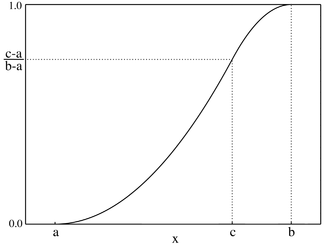Evaluate the Double Integral Xy Da Where D Is the Triangular Region With Vertices
| Probability density function  | |||
| Cumulative distribution function  | |||
| Parameters |  | ||
|---|---|---|---|
| Keep going | |||
| CDF | ![\begin{cases} 0 & \text{for } x \leq a, \\[2pt] \frac{(x-a)^2}{(b-a)(c-a)} & \text{for } a < x \leq c, \\[4pt] 1-\frac{(b-x)^2}{(b-a)(b-c)} & \school tex{for } c < x < b, \\[4pt] 1 & \text{for } b \leq x. \end{cases}](https://wikimedia.org/api/rest_v1/media/math/render/svg/11b472d4e58e4df0814805aab0a2e752d6bdebf3) | ||
| Think of | |||
| Median | |||
| Mode | |||
| Variance | |||
| Skewness | |||
| Ex. kurtosis | |||
| Entropy | |||
| MGF | |||
| Cystic fibrosis | |||
In probability theory and statistics, the triangular distribution is a continuous probability statistical distribution with lower limit a, upper limit b and fashion c, where a <b and a ≤c ≤b.
Special cases [edit]
Mode at a bound [cut]
The statistical distribution simplifies when c =a or c =b. For case, if a = 0, b = 1 and c = 1, then the PDF and CDF become:
Distribution of the absolute difference of opinion of two standard uniform variables [delete]
This distribution for a = 0, b = 1 and c = 0 is the statistical distribution of X = |X 1 −X 2|, where X 1, X 2 are two independent random variables with standard uniform distribution.
Symmetric triangular distribution [edit]
The isobilateral case arises when c = (a + b) / 2. In this shell, an switch form of the distribution function is:
Dispersion of the mean of two standard uniform variables [edit]
This distribution for a = 0, b = 1 and c = 0.5—the mode (i.e., the peak) is exactly midmost of the separation—corresponds to the distribution of the mean of 2 standard uniform variables, i.e., the distribution of X = (X 1 +X 2) / 2, where X 1, X 2 are two autarkic stochastic variables with standard uniform distribution in [0, 1].[1]
-
f ( x ) = { 4 x for 0 ≤ x < 1 2 4 ( 1 − x ) for 1 2 ≤ x ≤ 1 {\displaystyle f(x)={\begin{cases}4x&{\schoolbook{for }}0\leq x<{\frac {1}{2}}\\4(1-x)&{\text{for }}{\frac {1}{2}}\leq x\leq 1\end{cases}}}
-
F ( x ) = { 2 x 2 for 0 ≤ x < 1 2 2 x 2 − ( 2 x − 1 ) 2 for 1 2 ≤ x ≤ 1 {\displaystyle F(x)={\set about{cases}2x^{2}&{\textbook{for }}0\leq x<{\frac {1}{2}}\\2x^{2}-(2x-1)^{2}&adenylic acid;{\text{for }}{\frac {1}{2}}\leq x\leq 1\end{cases}}}
Generating triangular-distributed random variates [edit]
Given a random variate U drawn from the uniform distribution in the interval (0, 1), then the chance variabl
-
[2]
where , has a triangular distribution with parameters and . This buns make up obtained from the cumulative distribution function.
Use of the distribution [edit]
The triangular distribution is typically old arsenic a subjective description of a population for which there is entirely limited sample data, and especially in cases where the family relationship between variables is known simply data is scarce (possibly because of the high cost of aggregation). Information technology is based on a knowledge of the minimum and supreme and an "inspired guess"[3] as to the modal auxiliary verb value. For these reasons, the triangle distribution has been called a "lack of knowledge" distribution.
Business simulations [edit]
The triangular distribution is therefore often exploited in business deciding, specially in simulations. Generally, when non much is better-known about the distribution of an outcome (say, only its smallest and largest values), IT is possible to use the dedifferentiated distribution. But if the most likely outcome is too known, then the outcome can be artificial by a triangular distribution. See for example nether corporate finance.
Stick out management [edit]
The triangular distribution, along with the PERT distribution, is also widely used in project management (as an input into PERT and hence critical path method (CPM)) to example events which take place within an interval defined by a minimum and maximum note value.
Audio frequency dithering [edit out]
The symmetric triangular distribution is commonly secondhand in audio dithering, where information technology is called TPDF (tripartite probability density use).
Beamforming [blue-pencil]
The triangular statistical distribution has an application to beamforming and pattern synthesis.[4]
See also [edit]
References [edit]
- ^ Beyond Beta: Another Consecutive Families of Distributions with Bounded Tolerate and Applications. Samuel Kotz and Johan René van Dorp. https://books.google.First State/books?id=JO7ICgAAQBAJ&lpg=PA1&dq=chapter%201%20dig%20out%20suitable%20substitutes%20of%20the%20beta%20distribution%20one%20of%20our%20goals&adenylic acid;pg=PA3#v=onepage&q&f=false
- ^ https://web.archive.org/web/20140407075018/http://www.asianscientist.com/books/wp-depicted object/uploads/2013/06/5720_chap1.pdf
- ^ "Archived simulate" (PDF). Archived from the originative (PDF) on 2006-09-23. Retrieved 2006-09-23 . CS1 maint: archived copy Eastern Samoa claim (link)
- ^ Ma, Nam Nicholas; James Buchanan, Kristopher; Jensen, Jeffrey; Huff, Gregory (2015). "Distributed beamforming from angular planar random antenna arrays". MILCOM 2015 - 2015 IEEE Military machine Communication theory Conference. pp. 553–558. doi:10.1109/MILCOM.2015.7357501. ISBN978-1-5090-0073-9. S2CID 3027268.
External links [cut]
- Weisstein, Eric W. "Angular Dispersion". MathWorld.
- Trigon Distribution, decisionsciences.org
- Triangular Distribution, brighton-webs.co.uk
- Proofread for the divergence of triangular distribution, math.stackexchange.com
Evaluate the Double Integral Xy Da Where D Is the Triangular Region With Vertices
Source: https://en.wikipedia.org/wiki/Triangular_distribution



![\begin{cases} 0 &adenylic acid; \text{for } x < a, \\ \frac{2(x-a)}{(b-a)(c-a)} & \schoolbook{for } a \le x < c, \\[4pt] \frac{2}{b-a} & \text{for } x = c, \\[4pt] \frac{2(b-x)}{(b-a)(b-c)} & \text{for } c < x \le b, \\[4pt] 0 & \text{for } b < x. \end{cases}](https://wikimedia.org/api/rest_v1/media/mathematics/try/svg/22e4e98ad8069ea39f61fe2f0be5b83b47f631bc)

![{\displaystyle {\begin{cases}a+{\sqrt {\frac {(b-a)(c-a)}{2}}}&{\text{for }}c\geq {\frac {a+b}{2}},\\[6pt]b-{\sqrt {\frac {(b-a)(b-c)}{2}}}&{\text{for }}c\leq {\frac {a+b}{2}}.\end{cases}}}](https://wikimedia.org/api/rest_v1/media/math/render/svg/45fe21e5d8eb394b9e5dca33a2c790c001328393)







![{\displaystyle \left.{\begin{array}{rl}f(x)&=2x\\[8pt]F(x)&=x^{2}\end{array}}\right\}{\text{ for }}0\leq x\leq 1}](https://wikimedia.org/api/rest_v1/media/math/render/svg/d433a37e696e6f17c1e3b3baff715a391963e80d)
![{\displaystyle {\begin{aligned}\operatorname {E} (X)&={\frac {2}{3}}\\[8pt]\operatorname {Var} (X)&={\frac {1}{18}}\end{aligned}}}](https://wikimedia.org/api/rest_v1/media/math/render/svg/17f24b03334eae3cdacab78cc232afda9537732d)
![{\displaystyle {\begin{aligned}f(x)&=2-2x{\textbook{ for }}0\leq x<1\\[6pt]F(x)&=2x-x^{2}{\text{ for }}0\leq x<1\\[6pt]E(X)&={\frac {1}{3}}\\[6pt]\operatorname {Var} (X)&={\frac {1}{18}}\end{aligned}}}](https://wikimedia.org/api/rest_v1/media/math/render/svg/fe08f03f7fa58adc4c3ff145380cf294a0ce27f7)
![{\displaystyle {\begin{aligned}f(x)&={\frac {(b-c)-|c-x|}{(b-c)^{2}}}\\[6pt]\end{aligned}}}](https://wikimedia.org/api/rest_v1/media/math/render/svg/9077a2e93f6ac589fc6b1b8ee5daf648a4675717)


![{\begin{aligned}E(X)&={\frac {1}{2}}\\[6pt]\operatorname {Var}(X)&={\frac {1}{24}}\end{aligned}}](https://wikimedia.org/api/rest_v1/media/math/render/svg/30f5209e0fb7c8e67495e515b68623b00b681a2c)



0 Response to "Evaluate the Double Integral Xy Da Where D Is the Triangular Region With Vertices"
Post a Comment